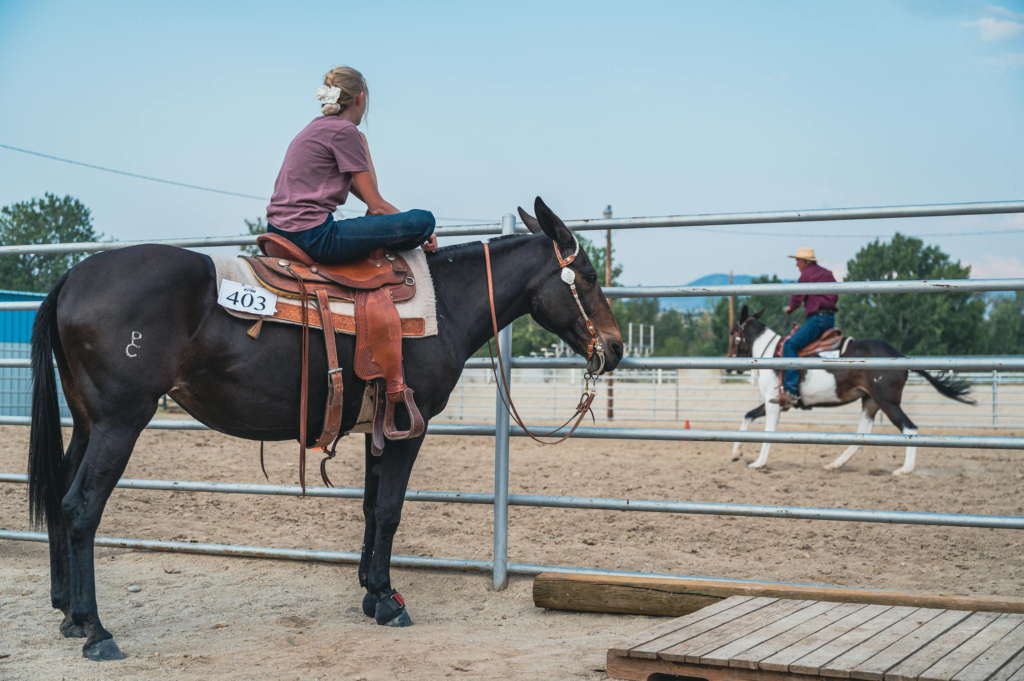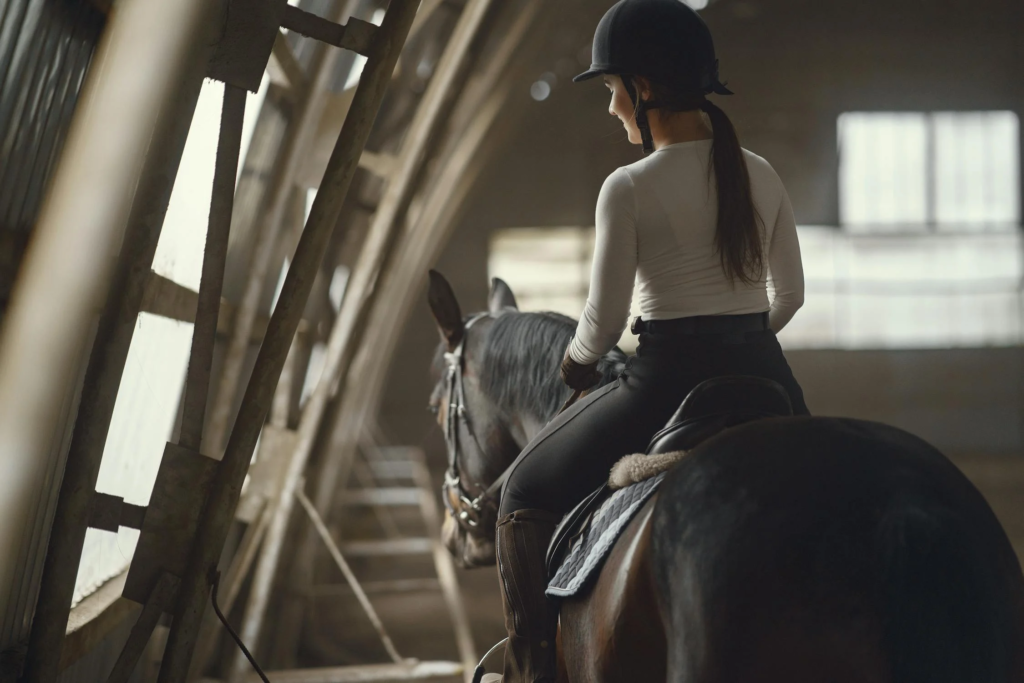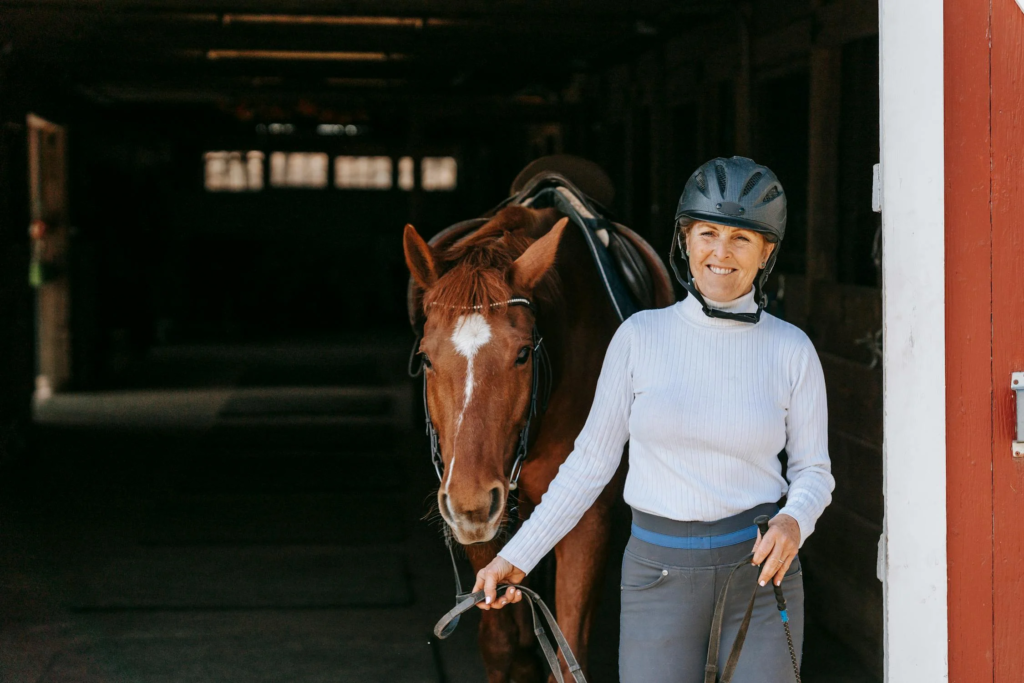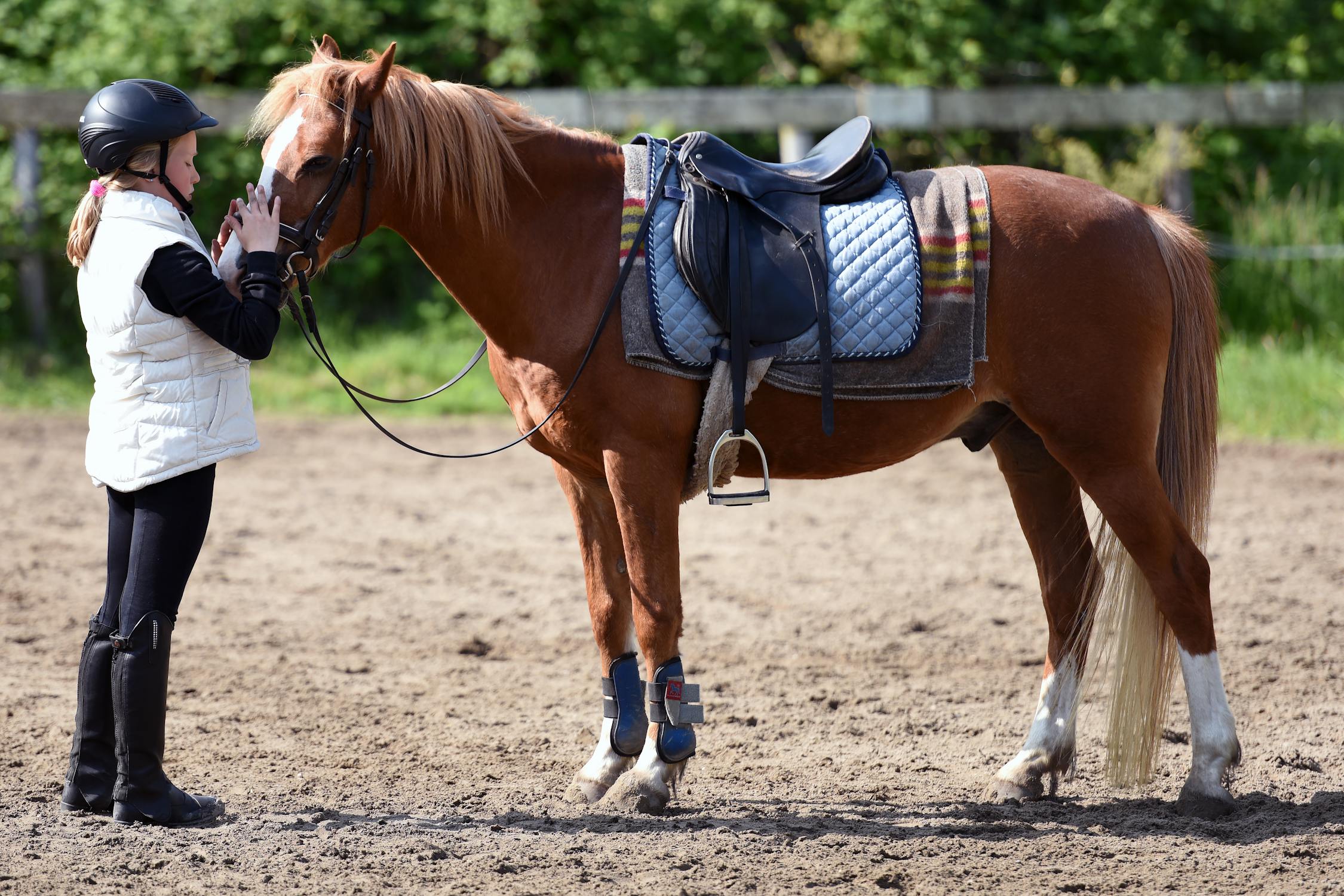Table of Contents
How to improve equestrian skills is a question every rider asks at some point. Whether you’re a beginner working on balance or an experienced rider refining advanced techniques, there’s always room for growth. Riding isn’t just about staying in the saddle—it’s about developing a deeper connection, improving technique, and building confidence.
From perfecting posture to understanding horse behavior, small changes can make a big difference. In this guide, we’ll explore proven ways to improve equestrian skills, covering everything from rider position and groundwork to training exercises and mental strategies.
Let’s dive into Part 1 and start your journey to becoming a better rider.
How to Improve Equestrian Skills: Understanding the Basics of Horse Riding
Developing a Strong Foundation in Riding
Every great rider starts with solid fundamentals. Before advancing to complex techniques, it’s essential to have a firm grasp of the basics. A proper stance, a balanced seat, and clear communication with your horse set the stage for effective riding.
How to Improve Equestrian Posture for Better Balance
Your posture plays a massive role in improving horse riding. If you slump forward or grip too tightly with your legs, your horse will pick up on your tension. To maintain balance:
- Keep your heels down and your back straight.
- Relax your hands while maintaining steady contact with the reins.
- Distribute your weight evenly in the saddle.
A balanced position allows you to move with the horse rather than against it, improving your overall control and confidence.
How to Improve Equestrian Communication by Understanding Horse Behavior
Horses are incredibly intuitive animals, often responding to subtle cues from their riders. Learning to read equine body language helps improve communication. Pay attention to:
- Ear position—forward means alert, pinned back may indicate discomfort.
- Tail movement—excessive swishing could signal irritation.
- Breathing patterns—deep, steady breaths suggest relaxation, while quickened breaths might indicate stress.
Building trust with your horse is just as important as refining your riding technique. When you respond appropriately to your horse’s signals, you create a more harmonious riding experience.
How to Improve Equestrian Comfort with the Right Tack and Equipment
The right equipment can significantly impact comfort and performance for both horse and rider. Ill-fitting tack can cause discomfort or even behavioral issues. Consider:
- A well-fitted saddle to prevent pressure points.
- Proper reins and bit for gentle yet effective control.
- Boots for both horse and rider to protect against injury.
It’s worth investing time into checking equipment before every ride. A comfortable horse is a more willing and responsive partner.
That wraps up Part 1. Stay tuned for Part 2, where we’ll discuss refining riding techniques and how to develop a deeper connection with your horse.
How to Improve Equestrian Riding Techniques for Better Control

Mastering the Art of Soft Hands
One of the most common mistakes riders make is using too much rein pressure. A heavy hand can make a horse resistant, uncomfortable, or even anxious. Instead, aim for light, consistent contact with the reins, allowing your horse to respond to subtle cues.
To develop softer hands:
- Keep your wrists relaxed and avoid stiffening your fingers.
- Maintain a steady but gentle hold—think of holding a delicate ribbon rather than gripping tightly.
- Follow the horse’s natural head movement instead of restricting it.
Riding with soft hands encourages trust and a more responsive horse, improving overall communication between you and your equine partner.
How to Improve Equestrian Leg Control for a More Responsive Horse
Many riders rely too much on their hands and not enough on their legs. A well-trained rider knows how to communicate using subtle leg aids. To improve leg control:
- Apply gentle pressure instead of kicking.
- Use your calves, not just your heels, to encourage movement.
- Balance your cues, avoiding an over-reliance on either rein or leg aids.
A well-timed leg cue can signal turns, transitions, or even encourage engagement from the horse’s hindquarters.
How to Improve Equestrian Seat Position for Stability
A deep seat allows you to move with the horse rather than bounce against the saddle. If you often feel unsteady at faster gaits, focusing on your seat can help stabilize your ride.
- Sit deep into the saddle, engaging your core.
- Relax your hips to absorb movement.
- Avoid gripping with your knees—this creates tension and reduces flexibility.
A deep seat not only improves balance but also enhances your ability to stay in sync with your horse’s movement.
Practicing Transitions for a More Responsive Horse
Transitions—moving smoothly from walk to trot, trot to canter, and back down—are essential for refining equestrian skills. They help with rhythm, engagement, and responsiveness.
To execute seamless transitions:
- Prepare ahead—think about the transition before asking for it.
- Use half-halts—a slight rein and seat cue to signal a change.
- Stay balanced—avoid throwing your weight forward or pulling on the reins abruptly.
Horses that respond promptly to transitions are more attentive and easier to ride.
Developing Better Coordination with Groundwork
Groundwork isn’t just for training young horses—it helps riders refine timing, control, and communication. Simple exercises like lunging, long-lining, and in-hand work strengthen the bond between horse and rider.
Benefits of groundwork include:
- Improving your horse’s responsiveness to cues.
- Strengthening muscles and flexibility.
- Teaching patience and relaxation before riding.
Spending time on groundwork translates directly to better riding performance.
That concludes Part 2! In Part 3, we’ll focus on building confidence and overcoming common riding challenges to make every ride smoother and more enjoyable.
How to Improve Equestrian Confidence and Overcome Riding Challenges

How to Improve Equestrian Confidence by Conquering Fear in the Saddle
Even experienced riders face moments of uncertainty. Whether it’s a fall, a spooky horse, or a lack of confidence in your abilities, overcoming fear is crucial for improving equestrian skills.
To rebuild confidence:
- Take small steps—set realistic goals and progress gradually.
- Practice deep breathing to stay relaxed and focused.
- Ride a calm, trustworthy horse to rebuild trust in the saddle.
Fear often comes from uncertainty, so the more you understand your horse and your own abilities, the more secure you’ll feel.
How to Improve Equestrian Handling of Spooky or Nervous Horses
A reactive horse can shake even the most composed rider. Instead of tightening up or overcorrecting, stay calm and guide your horse through the situation.
- Keep your hands steady—jerking the reins can make things worse.
- Use your voice—a reassuring tone can settle an anxious horse.
- Expose your horse gradually to new environments and objects.
If your horse senses that you’re calm, they’re more likely to relax too.
Improving Balance and Stability in the Saddle
Wobbly rides are frustrating, but balance issues can often be fixed with a few adjustments:
- Strengthen your core—a strong midsection helps absorb movement.
- Focus on independent seat control—your hands and legs should move freely without gripping for stability.
- Use stirrup length to your advantage—too short or too long can throw off balance.
Practicing no-stirrup work can dramatically improve stability over time.
How to Improve Equestrian Patience When Facing Training Plateaus
Progress in horse riding techniques isn’t always linear. Hitting a plateau can be discouraging, but it’s a normal part of learning.
- Switch up your routine—try new exercises or disciplines to keep things fresh.
- Take breaks when needed—overworking yourself or your horse can lead to burnout.
- Celebrate small wins—every improvement, no matter how minor, is worth recognizing.
Patience is key—sometimes, taking a step back helps you move forward.
How to Improve Equestrian Bonding for a Stronger Rider-Horse Relationship
A solid partnership between rider and horse isn’t built overnight. Spending time together outside of riding strengthens trust and communication.
- Groom regularly—hands-on care fosters connection.
- Talk to your horse—your voice can be soothing and reassuring.
- Respect their limits—pushing too hard can create resistance.
The best riders don’t just control their horses; they understand and listen to them.
That wraps up Part 3! In Part 4, we’ll dive into training exercises to refine your horse’s skills and responsiveness. Stay tuned!
How to Improve Equestrian Training Exercises for a More Skilled Horse

Groundwork Drills for Better Communication
Before even stepping into the saddle, groundwork can fine-tune your horse’s responsiveness. It strengthens trust, improves focus, and refines movement control.
Understanding a horse’s behavioral traits is essential in groundwork. Positive reinforcement and structured exercises help improve communication between rider and horse. The Oklahoma State University guide on training horses safely provides expert advice on how to build trust and improve responsiveness through proper groundwork techniques
Some useful groundwork exercises include:
- Lunging with voice commands – Helps your horse respond to cues from the ground.
- Yielding the hindquarters – Teaches better control and flexibility.
- Backing up in-hand – Reinforces respect for personal space and responsiveness.
A horse that listens well on the ground is more likely to be attentive under saddle.
Suppling Exercises to Improve Flexibility
A stiff horse struggles with balance, responsiveness, and collection. Regular suppling work makes movement smoother and more fluid.
Try these:
- Serpentines – Encourages bending and suppleness.
- Leg yields – Helps your horse move off your leg with ease.
- Stretching exercises – Allow your horse to extend through its neck and back.
Flexibility leads to better balance and a more comfortable ride.
How to Improve Equestrian Coordination with Pole Work
Cavaletti and ground poles aren’t just for jumpers—they help with rhythm, engagement, and coordination.
- Walk and trot over poles – Encourages precise hoof placement.
- Raised poles – Strengthen core muscles and improve lift.
- Gridwork for jumping horses – Builds confidence and technique over fences.
Horses that engage their hindquarters more effectively move with greater power and stability.
How to Improve Equestrian Responsiveness with Transitions
Sharp, smooth transitions show a horse’s responsiveness and balance. Practice:
- Halt to trot – Engages the hind end and improves reaction time.
- Trot to walk to halt – Reinforces control and listening skills.
- Walk to canter – Encourages engagement without rushing.
A well-trained horse should respond to subtle cues, not forceful aids.
How to Improve Equestrian Precision and Collection with Lateral Work
Lateral exercises build strength, flexibility, and control. They also refine a rider’s ability to communicate through seat and leg aids.
Try incorporating:
- Shoulder-in – Encourages proper alignment and suppleness.
- Haunches-in – Strengthens the hindquarters and improves balance.
- Half-pass – Develops coordination and collection.
These movements are beneficial for all riding disciplines, from dressage to western riding.
That concludes Part 4! In Part 5, we’ll focus on fitness and conditioning for both horse and rider to ensure peak performance and longevity.
How to Improve Equestrian Fitness and Conditioning for Rider and Horse

How to Improve Equestrian Core Strength for Better Riding
A rider’s core strength directly affects balance, posture, and control in the saddle. A weak core can lead to instability, making it harder to communicate effectively with your horse.
Some of the best exercises for equestrians include:
- Planks – Build endurance and stability for long rides.
- Leg raises – Strengthen lower abdominal muscles to improve posture.
- Squats and lunges – Develop leg strength for better grip and control.
By incorporating regular strength training, riders can maintain a steady position and avoid unnecessary bouncing in the saddle.
How to Improve Equestrian Flexibility and Coordination
Tight muscles limit movement, making it difficult to follow the horse’s motion. Flexibility exercises help with suppleness and comfort during rides.
Key stretches include:
- Hip openers – Improve leg positioning and reduce tension.
- Hamstring stretches – Prevent stiffness and enhance lower body mobility.
- Shoulder stretches – Allow for softer rein contact and better upper body control.
A flexible rider moves more naturally with the horse, improving overall performance.
Cardiovascular Fitness for Endurance
Riding can be physically demanding, especially during long sessions or competitions. Building endurance ensures that you stay focused and effective throughout the ride.
Recommended activities:
- Running or cycling – Improve cardiovascular health and stamina.
- Jump rope – Enhances coordination and strengthens leg muscles.
- Swimming – A low-impact way to increase lung capacity and overall fitness.
Better endurance means a stronger, more responsive rider.
How to Improve Equestrian Horse Fitness and Strength
Just like riders, horses need proper conditioning to stay sound and perform well. A well-conditioned horse is more balanced, responsive, and less prone to injury.
Some key fitness exercises include:
- Hill work – Strengthens hindquarters and improves balance.
- Long, slow distance riding – Builds stamina and aerobic capacity.
- Interval training – Helps develop speed, agility, and strength.
A well-rounded conditioning plan keeps a horse fit for any discipline, whether it’s dressage, jumping, or trail riding.
How to Improve Equestrian Performance by Preventing Injuries
Skipping warm-ups or cool-downs can lead to stiffness and soreness. A proper routine helps prevent injuries and keeps both horse and rider feeling their best.
Warm-up tips:
- Start with a relaxed walk to loosen up muscles.
- Gradually increase intensity before jumping into full work.
Cool-down essentials:
- End with light trotting or walking to bring heart rates down.
- Incorporate gentle stretches to maintain flexibility.
Taking a few extra minutes to warm up and cool down can make a big difference in overall performance and recovery.
That wraps up Part 5! In Part 6, we’ll explore nutrition and proper care for horses and riders to maintain peak health and energy levels.
How to Improve Equestrian Nutrition and Proper Horse Care

Essential Nutrients for a Healthy Horse
A horse’s diet plays a crucial role in performance, energy levels, and overall well-being. Proper nutrition helps maintain strong muscles, a healthy digestive system, and sustained stamina.
A balanced diet should include:
- Forage (hay or pasture) – The foundation of every horse’s diet, providing fiber for digestive health.
- Concentrates (grains or pelleted feed) – Used to supplement energy needs for active horses.
- Vitamins and minerals – Essential for bone strength, muscle function, and coat health.
- Fresh, clean water – A horse can drink up to 10 gallons a day, depending on weather and workload.
Adjusting your horse’s diet based on workload, age, and health conditions ensures they receive the right nutrients without excessive weight gain or loss.
Common Feeding Mistakes to Avoid
Even experienced riders can make errors when it comes to feeding. Some common mistakes include:
- Overfeeding grain – Can lead to digestive issues like colic or laminitis.
- Not providing enough forage – A lack of fiber can cause ulcers and behavioral problems.
- Ignoring hydration – Dehydration impacts performance and recovery.
Keeping an eye on body condition and adjusting portions as needed is key to maintaining a healthy horse.
Rider Nutrition for Better Stamina and Focus
Just like horses, riders need proper fuel to stay strong, focused, and energized in the saddle. Poor eating habits can lead to fatigue, poor posture, and reduced reaction time.
For sustained energy, riders should focus on:
- Protein-rich foods – Lean meats, eggs, nuts, and legumes help with muscle recovery.
- Complex carbohydrates – Whole grains, fruits, and vegetables provide steady energy.
- Hydration – Drinking enough water prevents muscle cramps and dizziness.
Skipping meals or relying on processed foods can leave riders feeling sluggish and unfocused, affecting both their performance and their horse’s experience.
The Role of Supplements for Horses and Riders
In some cases, supplements can help fill nutritional gaps. However, they should never replace a balanced diet.
For horses, useful supplements include:
- Joint support (glucosamine, MSM, hyaluronic acid) for older or hard-working horses.
- Electrolytes to replace minerals lost through sweat.
- Probiotics for improved digestion and gut health.
For riders, beneficial supplements include:
- Magnesium for muscle relaxation and stress reduction.
- Omega-3 fatty acids for joint health and mental clarity.
- Iron and B vitamins to combat fatigue and maintain endurance.
Always consult a veterinarian or nutritionist before adding supplements to your horse’s routine.
Proper Grooming and Care for a Happy Horse
Good nutrition is just one piece of the puzzle—proper grooming and maintenance also play a role in keeping your horse comfortable and healthy.
Daily care should include:
- Brushing to remove dirt and improve circulation.
- Hoof cleaning to prevent infections and lameness.
- Checking for injuries or soreness before and after rides.
A well-groomed horse is more comfortable and ready to perform at its best.
That wraps up Part 6! In Part 7, we’ll discuss mental training, discipline-specific techniques, and how to continuously improve your equestrian journey. Stay tuned!
Mental Training and Discipline-Specific Techniques
Developing a Focused and Positive Mindset
Equestrian success isn’t just about physical ability—mental strength plays a huge role in performance. A rider’s mindset affects decision-making, reaction time, and overall confidence in the saddle.
To improve mental toughness:
- Visualize success – Picture smooth transitions, steady hands, and a responsive horse.
- Practice mindfulness – Staying present in the moment prevents overthinking.
- Set realistic goals – Break progress into small, achievable steps to maintain motivation.
A focused rider makes better decisions, helping to build trust between horse and rider.
Overcoming Mental Blocks and Performance Anxiety
Every rider faces setbacks, whether it’s fear after a fall, competition nerves, or frustration over slow progress. Overcoming these mental barriers requires patience and strategy.
Some ways to push through mental blocks include:
- Positive self-talk – Replace negative thoughts with constructive ones.
- Controlled breathing techniques – Help reduce tension before and during a ride.
- Exposure therapy – Gradually work through fears instead of avoiding them.
A confident mindset can turn challenges into learning opportunities rather than roadblocks.
Adapting Techniques for Different Equestrian Disciplines
Each riding discipline requires unique skills, and refining those techniques is key to improving equestrian skills.
Dressage: Precision and Harmony
Dressage riders must focus on fluid movements, engagement, and accuracy. To refine dressage techniques:
- Perfect half-halts to maintain balance and rhythm.
- Work on impulsion to create energy without rushing.
- Improve straightness to enhance lateral movements.
Small refinements in dressage make a significant difference in execution and scores.
One key aspect of dressage is ensuring that the horse responds to subtle aids and maintains proper collection. Learning how dressage horses are trained can help riders understand the importance of engagement, balance, and rhythm in this discipline.
Show Jumping: Timing and Accuracy
Jumping riders need quick reflexes, strong position, and confidence over fences. To improve:
- Count strides between jumps to develop better rhythm.
- Use gridwork exercises to refine technique and precision.
- Focus on looking ahead to maintain balance and direction.
Jumping success comes from a balance of boldness and control.
Western Riding: Control and Relaxation
Western disciplines like reining, cutting, and barrel racing require quick turns, steady hands, and a deep seat. Key improvements include:
- Developing light rein contact for subtle communication.
- Practicing rollbacks and spins to improve agility.
- Working on smooth stops to execute controlled sliding halts.
Western riders benefit from relaxation and responsiveness in both horse and rider.
Continuous Learning and Improving as a Rider
No matter the skill level, every equestrian should strive for ongoing improvement. The best riders stay open to learning new techniques and refining old ones.
Ways to keep improving:
- Take lessons with experienced trainers to get personalized feedback.
- Watch professional riders to analyze body position and timing.
- Read books, watch videos, and attend clinics to stay informed on the latest training methods.
Great riders never stop learning—they evolve with every ride.
Frequently Asked Questions (FAQs)
How can I improve my balance while riding a horse?
Improving balance starts with correct posture and core strength. Keep your heels down, sit deep in the saddle, and engage your core muscles. Practicing no-stirrup riding and yoga for flexibility can also help enhance stability.
What are the best exercises for a beginner equestrian?
Beginners should focus on developing a secure seat, maintaining soft hands, and improving leg control. Groundwork, pole work, and basic transitions (walk-trot-halt) help build a strong foundation.
How do I get my horse to respond better to my cues?
Clear, consistent communication is key. Use light rein contact, proper leg pressure, and voice commands to guide your horse. Reinforcing commands through groundwork can also improve responsiveness.
What’s the best way to overcome fear after falling off a horse?
Start by taking small, confidence-building steps. Ride a calm horse in a controlled environment, use deep breathing techniques, and visualize positive rides. It’s okay to take your time before returning to more advanced riding.
How can I make my horse more flexible and supple?
Regular suppling exercises like serpentines, leg yields, and stretching help improve flexibility. Groundwork and lateral work encourage smoother, more fluid movement.
How often should I ride to improve my equestrian skills?
Consistency is key—riding 3 to 5 times a week helps build muscle memory and confidence. However, quality matters more than quantity, so structured practice with clear goals is more effective than just spending time in the saddle.
What should I eat before riding to maintain energy and focus?
Opt for light, energy-boosting meals like oatmeal, bananas, nuts, or a protein smoothie. Avoid heavy, greasy foods that could make you feel sluggish or uncomfortable while riding.
How do I know if my saddle fits correctly?
A properly fitted saddle should allow even weight distribution without pinching the horse’s back. Look for signs of discomfort like ear pinning, back soreness, or uneven sweat marks after riding. Consulting a saddle fitter can help ensure a perfect fit.
How do I build a stronger bond with my horse?
Spend time with your horse outside of riding—grooming, groundwork, hand grazing, and positive reinforcement help create trust and deepen your connection.
What’s the best way to strengthen my horse’s hindquarters?
Exercises like hill work, trot poles, and collected transitions engage the hindquarters and build strength. Lateral movements such as haunches-in and shoulder-in also improve muscle development.

